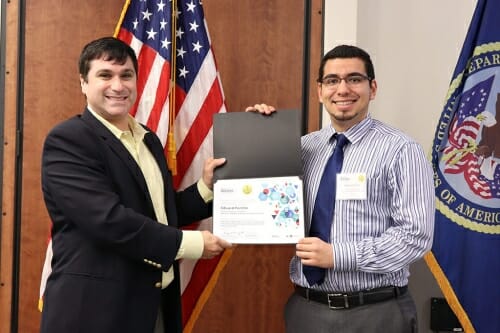A pharmacist-driven intervention to help veterans breathe easier
From February through June, we will be highlighting the ways that UW–Madison changes lives for the better throughout the state of Wisconsin. February’s theme is Improving Health. Watch for more at #UWChangesLives on social media. And here’s how you can help.
A pharmacist-led service to help veterans with COPD will be implemented nationally since being selected as a National Gold Status Practice by the Veterans Health Administration.
COPD CARE (Chronic Obstructive Pulmonary Disease Coordinated Access to Reduce Exacerbations) was developed by Ed Portillo, assistant professor in the UW–Madison School of Pharmacy, using the expertise of pharmacists to reduce hospital and emergency department visits.

Assistant Professor Ed Portillo being recognized as a Gold Status Fellow of the Veterans Health Administration’s Diffusion of Excellence program. Photo courtesy of the Diffusion of Excellence Program
“I am honored to have the opportunity to expand COPD CARE to improve veteran health, and to expand pharmacist involvement nationally within VA clinics,” says Portillo, who is also a pharmacist at the William S. Middleton Memorial Veterans Hospital, where he pioneered the service.
Veterans are three times more likely to suffer from COPD than civilians. In his clinical practice Portillo would see patients hospitalized weekly from exacerbations, which can be triggered by illness, like the flu or pneumonia, or irritants like allergens, pollutants, and smoke. But about one-third of COPD exacerbations have no identifiable cause.
Portillo’s service helps veterans who need it most, when they’ve recently been discharged from the hospital or emergency room with an exacerbation, he says. “The COPD CARE service is designed to keep veterans out of the hospital using our primary care teams.”
With COPD CARE, veterans discharged from the hospital for an exacerbation receive a 45-minute clinic visit with a clinical pharmacist and a registered nurse. The pharmacist provides COPD disease state management, including prescribing therapy, ordering labs, and placing referrals. Registered nurses educate the patient on an action plan for what to do to prevent a hospitalization when symptoms flare up and provide essential disease state education to patients.
“This is a team-based intervention where pharmacists are really managing patients during care transitions from the hospital to home, which is huge,” says Portillo. “It’s also specific to a high-risk disease state, but it’s integrated within primary care.”
That integration means care and prescriptions aren’t fragmented between different locations and providers. The primary care team, comprising a breadth of expertise, provides seamless care.
In a 2016 six-month trial of the program in Portillo’s practice, the new procedure dropped the 30-day readmission rate from 18.4 percent to 0 percent, while access to care (meaning a follow-up visit with a care provider) more than doubled, from 35.1 percent to 73.7 percent within 30 days of hospital or emergency room discharge.
The visit itself is crucial to implementing interventions to help veterans cope with COPD exacerbations, Portillo says. “If we want to reduce 30-day readmissions, pharmacists and our primary care teams have to be seeing patients in clinic as soon as possible.”
In the majority of cases, the COPD CARE service resulted in a prescription for essential maintenance inhalers, and referrals to important services including smoking cessation, pulmonary rehab to strengthen the muscles around patients’ lungs, and telehealth. In nearly 53 percent of visits, the pharmacist-nurse teams corrected patients’ inhaler technique, and in almost 37 percent of visits, their dosing frequency was also modified for better home care results.
“We’re empowering patients with the tools they need for more effective self-care,” says Portillo.
The VHA is the largest integrated health care system in the U.S., with more than 150 medical centers and 1,000 outpatient care sites. That coverage allows the system to serve more than 9 million veterans nationwide, but it also makes it difficult to efficiently identify and spread best practices.
“Because we have so many facilities and health care centers, there are pockets of innovation all around the country. The Shark Tank-style Diffusion of Excellence competition allows us to take those innovative practices and spread them across the VA,” Portillo says.
Since developing and testing this model of care—which was also earned national recognition as a Strong Practice in 2017 from the Clinical Pharmacy Practice Office Patient-Aligned Care Team, a pharmacy oversight office within the VHA—Portillo and his colleagues have utilized dissemination and implementation science to design an online training package to spread the service to interested VA facilities.
“Pharmacists are so well-trained to do this,” Portillo says. “Having us pharmacists in the forefront managing conditions, especially during care transitions, is like having a secret weapon to improve patient outcomes.”
Read more about it here.
